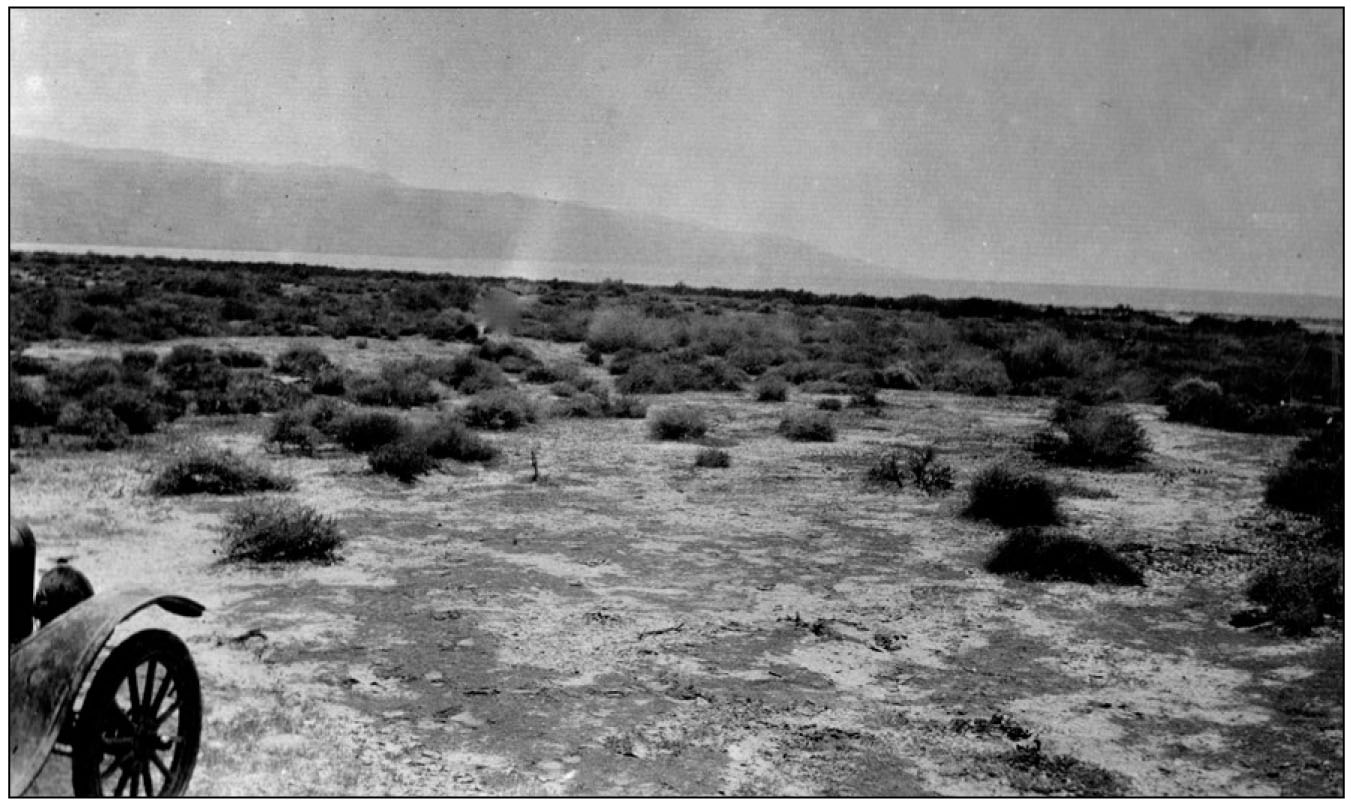
We were now in Palestine proper and settled down in billets in Richon where the Jewish villagers were doing their utmost to make us comfortable. In return we were able to give them our rations of sugar and tea, two luxuries they had been compelled to go without since the war began.
The 11th December was a red-letter day for the patrol. Instructions were received to hand in the old derelicts of cars that had served us so well over thousands of miles of all sorts of country and under all sorts of conditions.
We accordingly took them (with the mud of three continents and scars from many battles) to the headquarters of 956th Motor Transport Company who handed us out six new Fords in their place. The old buses had done their work nobly and it gave the drivers quite a pang to part with them when it came to the point. The drivers carefully removed the name plates before handing the machines in. Each car had been carefully named by its original crews and they were always known by their names in movements.
There was ANZAC (so named because it was supposed to have been used on the peninsula at Gallipoli) and was the oldest car in the patrol. Then came BILLZAC, which was generally the companion to ANZAC. OTASEL received its name from its tendency to warm the feet of its occupants and SILENT SUE because it was the quietest car in the fleet. IMSHI was so named on account of its speed capabilities. (IMSHI being the Egyptian word for clear out.) No 6 car was generally known as BUNG. This car carried the spare ammunition and some said that this was the reason for its name, but some held that there were other reasons.
Anyhow the old ones were gone and we now had to transfer our love to the new. For a couple of days we spent our time oiling, greasing and testing the mechanical parts, turning up engines, fitting up the machine-gun mountings, also our ration and ammunition containers to the best advantage. We were now able to dispense with the condensers, as owing to the cooler climate and harder ground these were not necessary for the radiators. The first job of the new vehicles was to distribute voting papers for the conscription referendum, which was done on the 13th December.
During the remainder of the month the Patrol was engaged in various small movements along the front. The weather had settled down to continuous rain and was extremely uncomfortable to all those moving outside their billets. Owing to the condition of the ground and the state of the roads neither side was able to make any very big movement. The patrol did quite a bit of escort work to and from Jerusalem along the road from Jaffa. This road, which was originally built a couple of thousand years back by the Romans, required extreme care in driving. The grades were very severe and the hairpin bends were too sharp for a vehicle with a long wheelbase to negotiate. Brakes on the motor cars and lorries were severely tested in coming down the 3000-foot drop from the Jerusalem hills to the plains below. Quite a number of motor vehicles were lost and unfortunately a number of men also through brake failures. At some of the bad corners the wrecks could be seen hundreds of feet below, generally with their four wheels upper-most and the contents scattered beneath. They were there forever and can probably still be seen by tourists where they act as a warning to fast drivers. The Jaffa-Jerusalem road in spite of its dangerous character was very important, and practically the only route from the coast to the hills of Judea. A large volume of motor transport was continually on the road carrying munitions, stores and food for the starving population and it soon became apparent that the road would not stand the heavy traffic.
Large numbers of native labourers were engaged in repairing and rebuilding the bad patches and several steamrollers were brought up. Fortunately, there was no shortage of road metal as the country on either side of the road was practically solid rock and was strewn with boulders and spalls, which only had to be broken and carried a few yards.
The women and girls from surrounding villages did a great deal of this work gathering the stones in baskets, which they carried, on their heads to the required places. These people were practically starving and they welcomed this work as they were fed and paid by the army authorities.
As our cars were continually journeying to and from Jerusalem along this road, we began to give serious consideration to the condition of the brakes. Although most of the British vehicles had ample braking surfaces this could not always be said for some of the cheaper type of cars used in the army and it was no exaggeration to say that sometimes a set of brake shoes would be worn out in one day’s work descending these hills. Most of the accidents that took place were caused by some failure in the transmission such as broken tail shaft or universal joint, faulty crown wheels and pinions.
It is unlikely that any of the members of the Light Car Patrol will forget their first trip to Jerusalem. Several of the bridges had been blown up by the retreating Turks and crossings had to be made through streams that were fortunately not too deep to negotiate with our cars. The approaches to the streams however, were extremely rough and steep and many huge boulders had to be levered aside. There was plenty of manhandling in order to get the vehicles up the steep banks of “one in one” and back to the track again. On one bridge the crown of the arch only was blown out and here we were able to place a couple of stout planks across the gap over which we drove in comfort. In spite of all the hard work the trip was well worth it all. The views from the heights around Jerusalem were wonderful.

37. Typical semi-desert terrain encountered by the 1st Light Car Patrol in Palestine. Despite their narrow tyres, the cars performed extremely well in this type of country (ATM ALC.022).
The British Headquarters had been established in a large German building on the Mount of Olives from the tower of which could be seen the blue Mediterranean to the west and twenty five miles away to the east could be clearly seen the Dead Sea which appeared to be only about five miles off. This sea and the Jordan Valley with Jericho, was over twelve hundred feet below the level of the Mediterranean on the other side. The enemy still held all this country below and our batteries in a valley alongside were busy plastering him with shrapnel and High Explosive while an occasional burst of one of the enemy shells in the village alongside seemed somehow to be quite out of place with the surroundings. The weather was clear and the visibility was wonderful. The roads could be clearly distinguished through the glasses, winding up the hills, thirty or forty miles away. We were later to know quite a lot about this country from very close acquaintance when we found out that some of it at least looked much better from a distance.
The heights of Jerusalem were very cold after our long sojourn in the desert. It was now nearing the middle of winter and our drivers felt the hail and sleet very severely as there was no protection on the cars while driving and most of them were quite glad to return to the comparatively warm climate of Jaffa and Richon after their visits to the hills.
Christmas Day was celebrated at the Richon-El-Zion. There was comparative quiet at the front, although two days previously an engagement had taken place at Mulebbis (a village several miles out). The inhabitants turned out in force to celebrate the occasion and the famous wine cellars of the town were drawn upon for the troops who were supplied with a liberal ration of the beautiful Tokay for which the district is famous. We had a church parade in the morning and in the afternoon the inhabitants provided a free banquet. Unfortunately, it rained most of the time, but nevertheless the troops enjoyed the occasion.
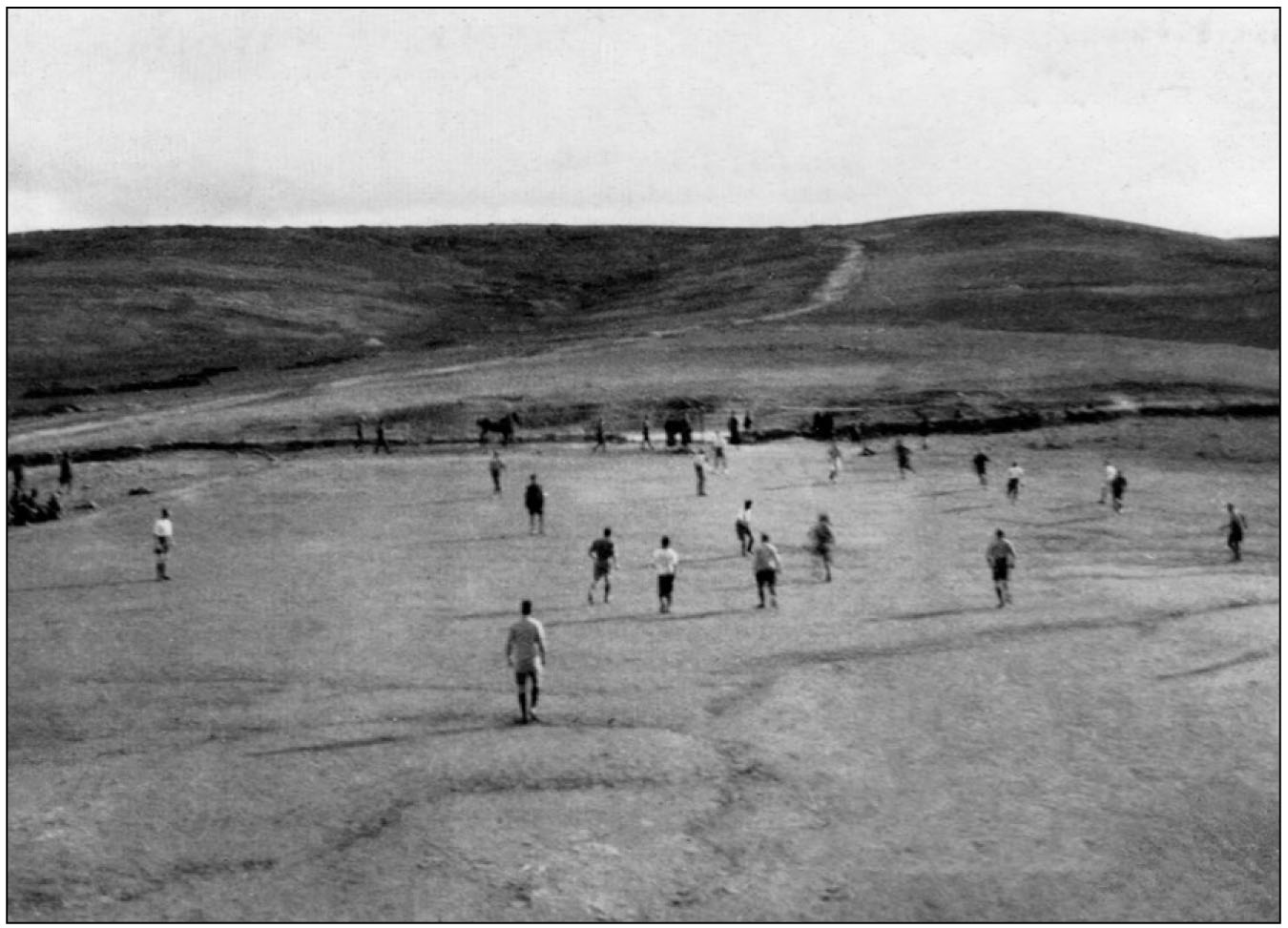
38. A game of football somewhere in Palestine (Creek collection ATM LCP.HC.006).
Two days later we moved away through seas of mud and water to the village of Esdud. During the month of January 1918, the unit was kept continually busy reconnoitring the various roads and tracks along the whole front from Jerusalem to the coast, but on the 17th February, we moved with the Australian and New Zealand Division to Jerusalem as a big operation was brewing on that flank. Next day we proceeded with Engineer officers to Solomon’s Pools on the Hebron Road to establish watering places for the horses and troops. On the 20th February the division proceeded along the back road to force the way to Jericho. Our orders were to take our cars and escort the motor transport along the Roman Road to Neby Musa, which overlooks Jericho. We proceeded satisfactorily for eight miles and after making a reconnaissance we found that the main road, which is very precipitous and steep, would be impassable for wheeled vehicles for many hours. We then went back to a rough track known as the “Pilgrims” road, which we worked along laboriously for about 4 miles until we came to the hill Gebel Ektief. Here we were compelled to stop as the hill was held in force by the enemy.
We placed the vehicles under cover of a neighbouring slope and climbed a hill opposite in time to view a wonderful charge by our infantry up the slopes of Gebel Ektief.
The hill had entrenchments near the summit and we noticed that the enemy troops in the trenches at the right flank at the approach of our infantry jumped out of the rear of their trenches and ran along the top of the trenches towards the other flank.
Later on we discovered that there was a sheer precipice behind them and they ran towards the other end to get away before it was too late. We were getting a wonderful dress circle view of the fight and in the excitement some of our men must have made themselves too conspicuous as a few minutes later we were plastered with shrapnel by the disgruntled enemy gunners.
Needless to say we soon left our front view seats and as the road was now comparatively clear of the enemy, we proceeded to our job of getting the transport along. We worked our way along for another very rough two miles when we came to a very steep decline of about 400 feet. This looked almost impossible, but we decided to try it out. So stripped every ounce possible off one of the vehicles and lowered it down the track with the men holding it back with ropes. We managed this successfully but decided to go on with the one car to reconnoitre the rest of the track before bringing more vehicles down the same way. We discovered however, that a little further on the track petered out altogether and any further progress was right out of the question, so we had over an hour’s hard work hauling the car back again with ropes up the steep slope. By this time it was dark, so we decided to spend the night where we were and after posting sentries, we took turns to sleep under the tarpaulins of the cars. Everybody was moving at the first streaks of dawn and we soon packed up and moved back over the track we had taken back again to the old Roman Jericho Road, and we found that the engineers had been busy during the night to such an extent that the parts of the road which had been blown up were now almost negotiable for light traffic, so by dint of a little more of our customary pushing and manhandling, we got our “Lizzies” over the worst places. The previous evening one of the “Rolls” Armoured Cars of the Light Armoured Car Battery in endeavouring to get across the Pilgrim Road got out of control owing to the severe and rough nature of the ground and got rather badly smashed over one of the cliffs. However, we heard that it was hauled up again and repaired next day. We soon reached the rocky hill by Talat-El-Dum where an old stone building (supposed to be the Good Samaritan’s Inn mentioned in the scriptures) gave us cover while we boiled the billy for breakfast. This building belied its name as throughout the night the machine-guns inside had kept up a continuous din, while the enemy gunners had made it their chief target for their artillery. We now had a large column of motor transport vehicles under our control and care and as we were very anxious to get these to the head of the column, we only spent a few minutes over breakfast. We pushed on with about a dozen motor vehicles following us and reached Headquarters at Neby Musa by midday. The Division now pushed on and took up positions at Jericho at 2 p.m. where Headquarters was established.
Apparently the enemy was aware of this fact as at 3.30 p.m. they began to drop shells there from a long range across the Jordan River.
The first shell that dropped caused considerable amusement. It could be heard whining for quite a time before it dropped. One of the natives of the village heard it coming and dropped flat on the ground. Strange to say the shell dropped in the mud almost beside him and smothered him with earth but did no further damage. The native then jumped up and ran until out of sight to the screams of laughter of the troops. One of the next shells went clean through the radiator of the Divisional Commander’s car and as this was one of the vehicles under our charge, we had to get busy. Things were getting too warm at this spot, so we moved camp to a new position about 400 yards away. We towed the General’s car away and dismantled the broken parts. After dark we sent a car back along the road towards Jerusalem for about 10 miles where some advanced motor transport stores were kept and he managed to obtain a new radiator, which he brought to us before midnight. Before daybreak the car was repaired and ready to move off with the rest of the fleet at reveille.
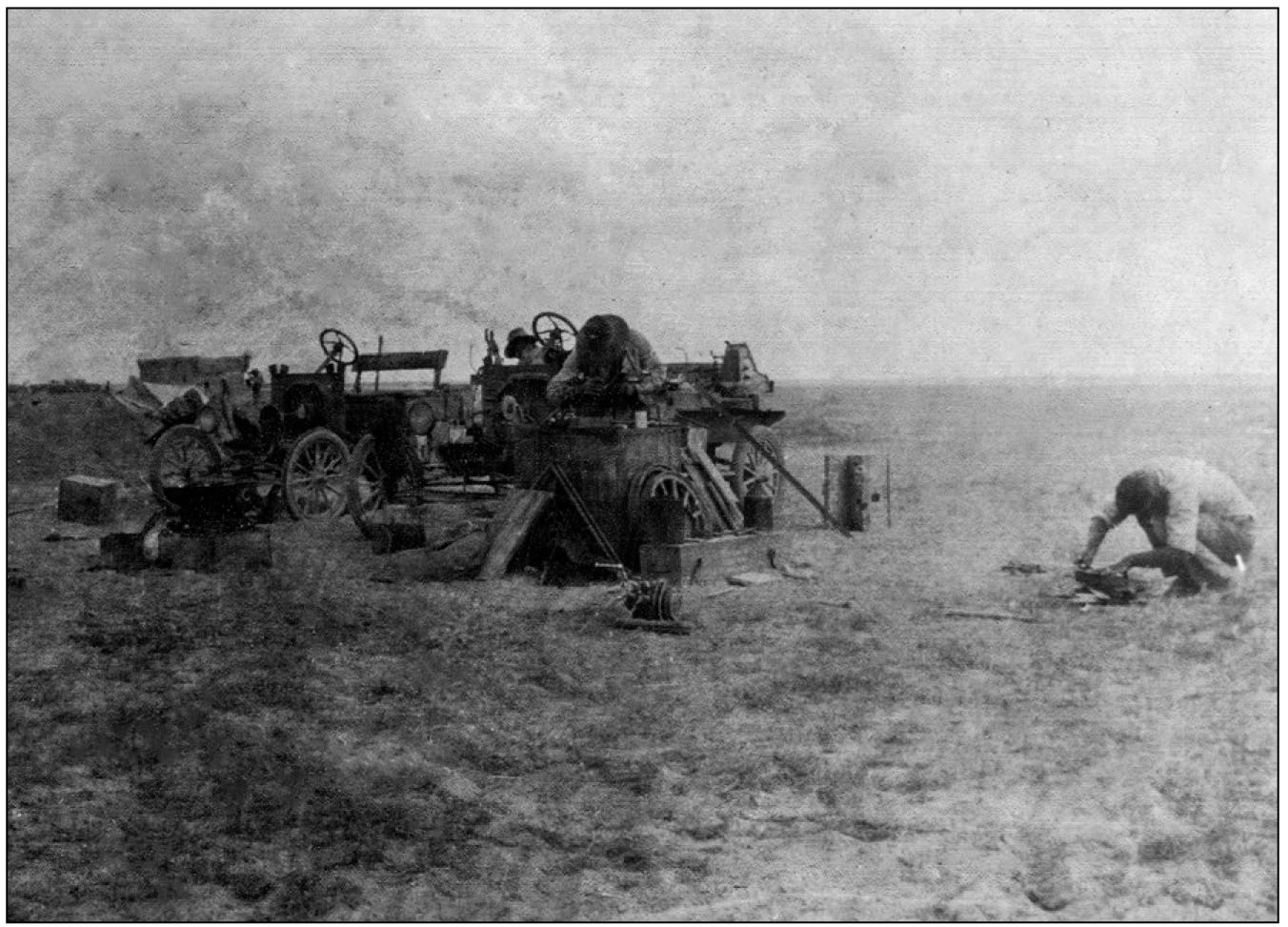
39. The tough conditions of the Palestine Campaign forced the 1st Light Car Patrol to become selfsufficient. Members of the unit undertake major repairs and servicing of their vehicles in makeshift circumstances (ATMLCP.002).
In the morning one half of the unit was ordered to patrol the road from Jericho to Jordan and the other half to reconnoitre a road marked on the map from Umm-Elha-Dumm to Neby Musa and the Jericho Road. We found this road to be merely a packhorse track, unfit for wheeled vehicles. We reconnoitred on foot for a few miles and made our report and received orders to proceed to Jerusalem where we arrived at 6 p.m. setting up camp in the cold and wet: very different to the warm valley at Jericho only twenty five miles away.
This was the middle of February, which was probably the coldest time of the year. For the next few weeks the patrol had very little excitement beyond a few reconnaissances around Jerusalem, Nailin and other parts of the front now extending from the River Jordan to the coast north of Jaffa. However, on the 13th March, we received orders to make the Jordan Valley our headquarters and this was apparently the flank where any future movements were to take place. Ten days afterwards we crossed the Jordan River by a pontoon bridge and received orders to reconnoitre the roads from the river to the base of the hills on the east now occupied by the Turkish Army. We found that most of the roads petered out into mule tracks once the hills were reached and only one road (that leading from Ghoranyeh where we had established a bridgehead) was suitable for wheeled transport. Next night, the Australian and New Zealand Mounted Division pushed on up the mule tracks and left their transport behind them. The men led their horses all night long up the steep hills in the rain and in the morning the division was on top of the hills pushing on towards Amman with the surprised enemy running before them.
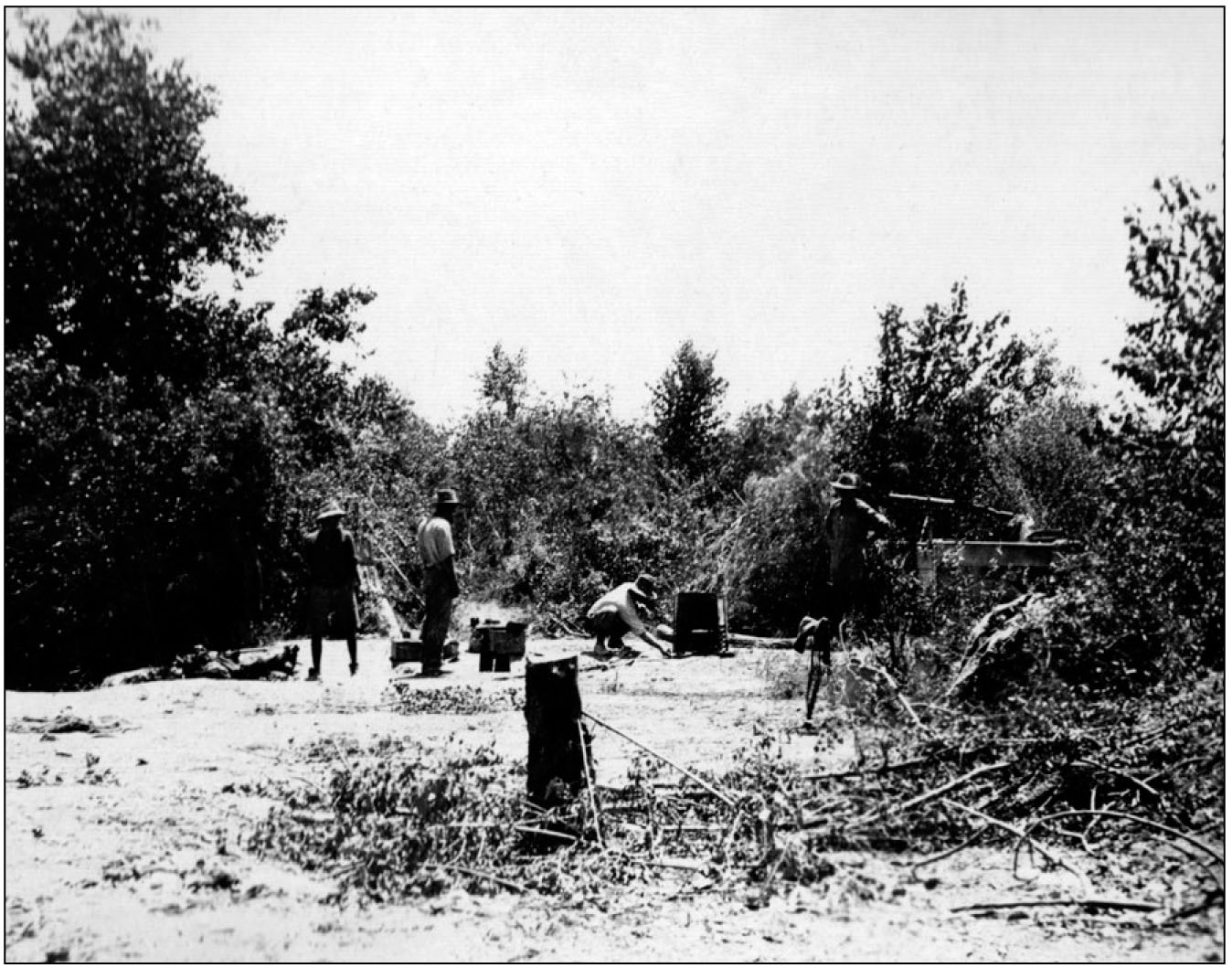
40. A forward outpost manned by the 1st Light Car Patrol on the Jordan River. The patrol would increasingly assume traditional cavalry roles of flank protection and lines of communication duties during the Palestine Campaign (Cornwell collection ATM.LCP.PC.014).
The Light Car Patrol received orders to proceed up the Ghoranyeh road with the infantry via Es Salt, which we did. We however, found considerable difficulty in getting through the heavy columns of the transport accompanying the infantry who had about six hours’ start of us and they had also added to the difficulties by churning the mud up along the road to the consistency of butter. By dusk we were within three miles of the town of Es Salt which had not yet been captured and as it was too dark to see where we were going there was nothing to do but camp for the night which we did alongside the road. Beyond an occasional shot from a few snipers in the hills, we had a fairly peaceful night. At daybreak next morning we were packed up and on the move again, shortly afterwards we drove into the town of Es Salt. The villagers welcomed us by firing fusillades from their rifles into the air. The villagers were very friendly to us and during the night they had prevented the Turks taking a battery of artillery away with them, the result that it fell into our hands next morning. We could not afford to waste much time in the town, as our instructions were to push on along the road taken by the retreating enemy in a north-easterly direction and soon left the infantry behind. We were now acting on our own in the open land between the two divisions without the slightest knowledge of where our own division was.
The so-called road was a veritable quagmire as during the night the whole of the Turkish and German transport had ploughed it until the mud was knee deep and the continuous rain during the night had not improved it. About 2 p.m. we captured a Turkish prisoner who had been wounded and as he could speak Arabic we learnt from him that his army was about two hours ahead in full retreat. We directed him to the rear and proceeded on our way. Two miles further on we overtook two German motor lorries hopelessly bogged. The first thing we did was to siphon the petrol tanks into our own as the heavy going was using our supplies of “juice” up too rapidly for our liking. We also put the engines out of action and pushed on. After another hour’s hard pushing and driving we came in sight of a large body of transport surrounded by men. On examining them through field glasses we saw that the transport consisted of 23 German army motor lorries and a number of cars. These had been abandoned and the men around them were hoards of Bedouins busy looting. A couple of rounds from the Lewis guns soon cleared this mob away and we shortly came up to inspect our new find. We discovered however, that the lorries and cars were all axle deep in mud and that it was almost impossible for us to proceed ourselves. We got a little more petrol and oil and after rendering the enemy vehicles hors-de-combat, we decided as it was rapidly getting dark we had better make ourselves secure for the night. We moved back along the road to a small hill about half a mile back which was comparatively dry and which commanded a fair view of the surrounding country and here we parked our cars in a square with a Lewis gun at each corner and after posting sentries we endeavoured to take turns at sleeping. This however, was not an easy matter as every now and then loud bursts of rifle fire kept occurring from various quarters. This turned out afterwards to be fights between various Circassian and Bedouin villages who were having a little war on their own and apparently were quite disinterested in our doings. We unfortunately did not know which of these were friendly or otherwise so had to keep all villagers at a distance. We sent a small patrol on foot under Sergeant Langley towards the east in order to get in touch with headquarters of the Mounted Division as we estimated that owing to the distance we had come we could not be more than a few miles away from them. Our estimate was not very far out as our patrol ran across their outposts about three miles away.
The patrol informed headquarters of our position and brought back the information that the mounted men were having a very rough time. Numbers of the wounded were dying from exposure, as no ambulances were able to traverse the country. When our patrol returned in the morning they brought back instructions for us to stay in the present position for the day and before dark to return to Es Salt. Fortunately, the day was dry and we spent the time drying our blankets and salvaging the magnetos and other useful parts from the German vehicles (these we handed in later on to the officer in charge of the motor workshops). During the day we got in touch with some men from the Anzac Division Signals who required petrol for the motor on their wireless outfit and we were able to spare them some of our loot for this purpose. Before dark according to instructions we retired to Es Salt, which we reached in time to make a comfortable camp for the night. However, before leaving our position of the night before, the advance party of the infantry division had reached us and was well on its way to junction with the mounted division.
We stayed next day at Es Salt and sent messages through to Divisional Headquarters asking for orders. Next day was Good Friday which we spent (also the three following days) in driving along the Es Salt to Amman Road and bringing in loads of wounded who were compelled to walk, as it was not possible for the ambulances to reach them. We were able, however, to give a pretty rough ride to quite a number of these poor chaps who were nearly dead with wounds, cold and exposure. Later on some of the light ambulances managed to get up into the hills and we received instructions to protect them from interference, which we did by continually patrolling the road.
The troops were having a pretty rough spin altogether. The weather was bitterly cold and wet and most of them were soaked to the skin, day and night. Some of the natives were also giving some trouble and there were rumours of retirement. All day and night the population of Es Salt and the surrounding district were slowly evacuating their homes and with their valuables packed began to march down the long road through the hills to the Jordan Valley over twenty miles below. Word had evidently reached the villagers that we intended to retire to the valley again shortly and they were fearful of the vengeance that the Turks, on their return, would turn upon them for helping the British during the advance. The road was becoming filled with refugees and it was pitiful to see tiny children and old people quite unfit for such a journey endeavouring to do the long walk with their bundles. On the 1st of April we received orders to evacuate Es Salt and return to Shunet Nimrin and the foot of the hills.
The trouble apparently was not that we could not hold our own in the hills but the difficulties of transport for supplies and ammunition were too great to keep up for an extended period. We now saw the worst side of war as we had to force our way through the panic stricken population and we could imagine what a retreat meant. Numbers of footsore and crying villagers asked for seats in our patrol cars and many of the men were quite willing to walk and let these poor people have their seats but this could not be allowed as military considerations had to come first and we had to be hard hearted and keep to our schedules. We left Shunet Nimrin at 6.30 am next day and proceeded to cross the Jordan at the Ghoranyeh Bridge about an hour later while the enemy aeroplanes were making things very lively by bombing the road and bridge-head. However, we managed to run the gauntlet without suffering in any respect and joined our old comrades the Anzac Mounted Division at Jericho about 11 o’clock and learnt of the rough times they had experienced in their retirement and how the Circassians and Bedouins who had feted them on their advance had sniped them from every rock on their return journey. So this was the end of the first Amman Stunt.
Next morning the enemy reminded us that the war was still on by bombing our camp at daybreak from their planes. However, our chaps were so tired or else were getting used to bombs to such an extent that the majority of them would not stir from their blankets.
The enemy was beginning to get a bit cheeky and they evidently thought that as we had retired from the hills we were beaten and on the 11th April they came down from the hills and after a lot of shelling they began to attack our bridgeheads on the Jordan. The Light Car Patrol received orders to take the Lewis guns out of the cars and to reinforce the 1st Light Horse Brigade who were holding the foothills across the river. We placed our guns in the trenches under orders from the Brigade and very soon had plenty of machine-gun practice opening up at 1200 yards, which was reduced later down to 500 yards range.
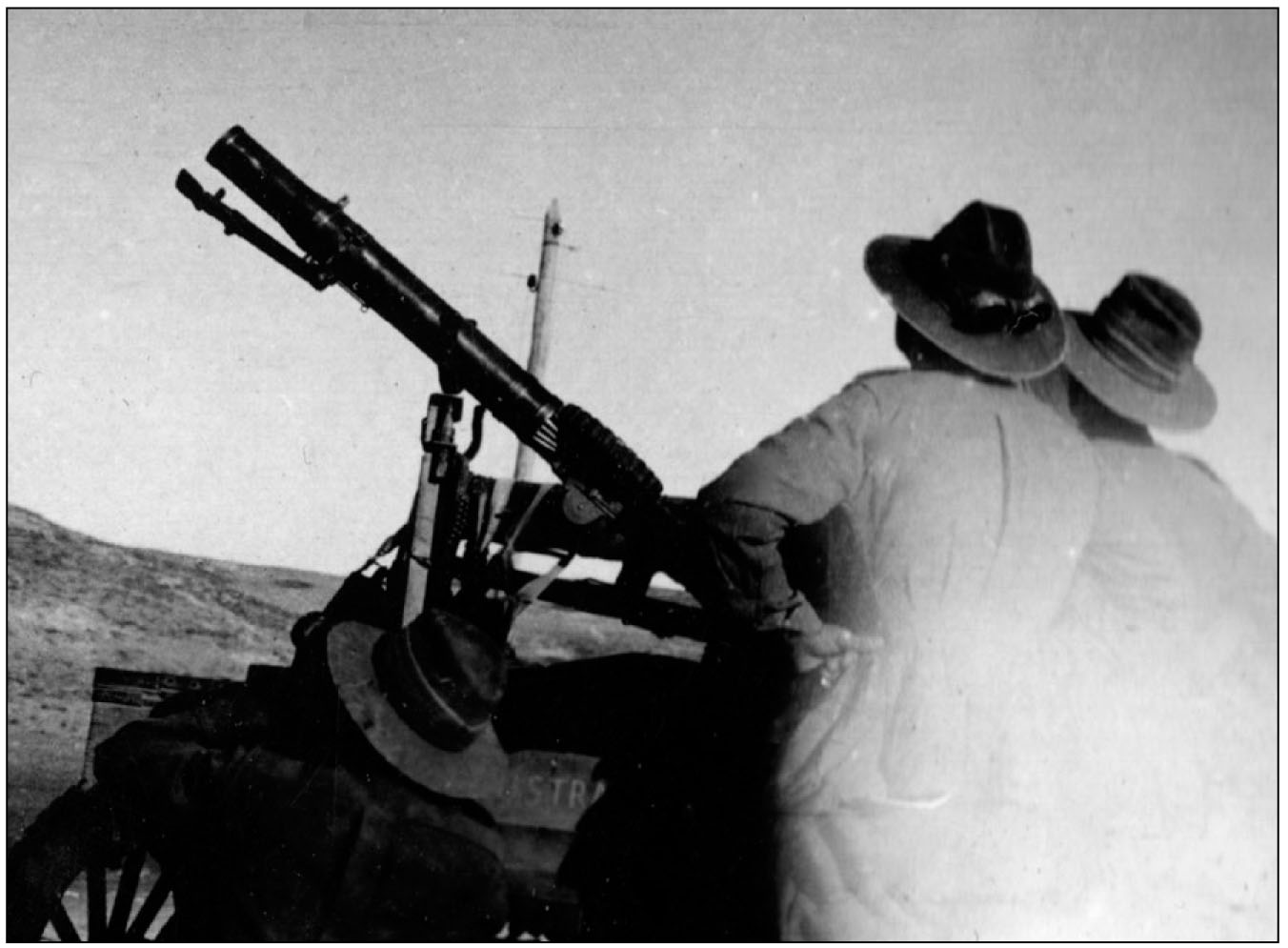
41. Detail of the Lewis light machine-gun and mounting on one of the Light Car Patrol’s Model T Fords. Part of the ‘Australia’ insignia can also be seen (ATM ALC019).
Next morning a large number of dead Turks were buried in front of our position so apparently the couple of thousand rounds of ammunition used by us was not all wasted. Our chaps relished the change of sitting down behind cover to do the shooting as generally the position was reversed and they were the targets. During the night the enemy retired to the hills again, sadder but wiser and it was quite a time before he picked up courage to make another attack.
After their attack on the 11th of April, the enemy became very quiet and un-enterprising. So a demonstration was made into his territory on the 18th and 19th to keep him busy and on the 24th the Armoured Cars and Light Car Patrols made a dash across the river and proceeded north for about 7 or 8 miles into enemy territory to have a look at his territory and dispositions. We toured around for a couple of hours and beyond provoking some of the batteries of artillery, which shelled us, we were not interfered with. The shelling did not affect us as the enemy discovered that quick moving motor cars make a very difficult target especially when they do not adhere to a fixed road. We returned back again to camp shortly after midday by our old pontoon bridge. Next day we crossed the river again and this time we proceeded in a southerly direction through scrub and new country along the east coast of the Dead Sea. Our duty this time was to cover a working party who were endeavouring to salvage a damaged enemy motor boat, which had been beached along the coast some miles south-east of the mouth of the Jordan. We encountered about half a squadron of enemy cavalry about four miles along the coast. These men scattered to the hills on seeing our cars and as our job was to cover the working party we did not give chase and left them alone after firing a few shots to hurry them along. The working party managed to get the boat afloat and they towed it with a motor boat to Rujm-el-Bahr, a rendezvous on the north of the Dead Sea. We arrived back at Headquarters about 4 o’clock in the afternoon with several broken springs owing to the extremely rough ground covered along the coast. We found on examination that there was scarcely a sound spring on any car in the patrol so in the evening we sent off a car post-haste to Richon and Ludd via Jerusalem, a trip of about 60 miles each way to fetch back a fresh supply of spring plates. We received these next evening and after a busy night we had all springs repaired and replaced, the cars ready for anything but the men rather weary.
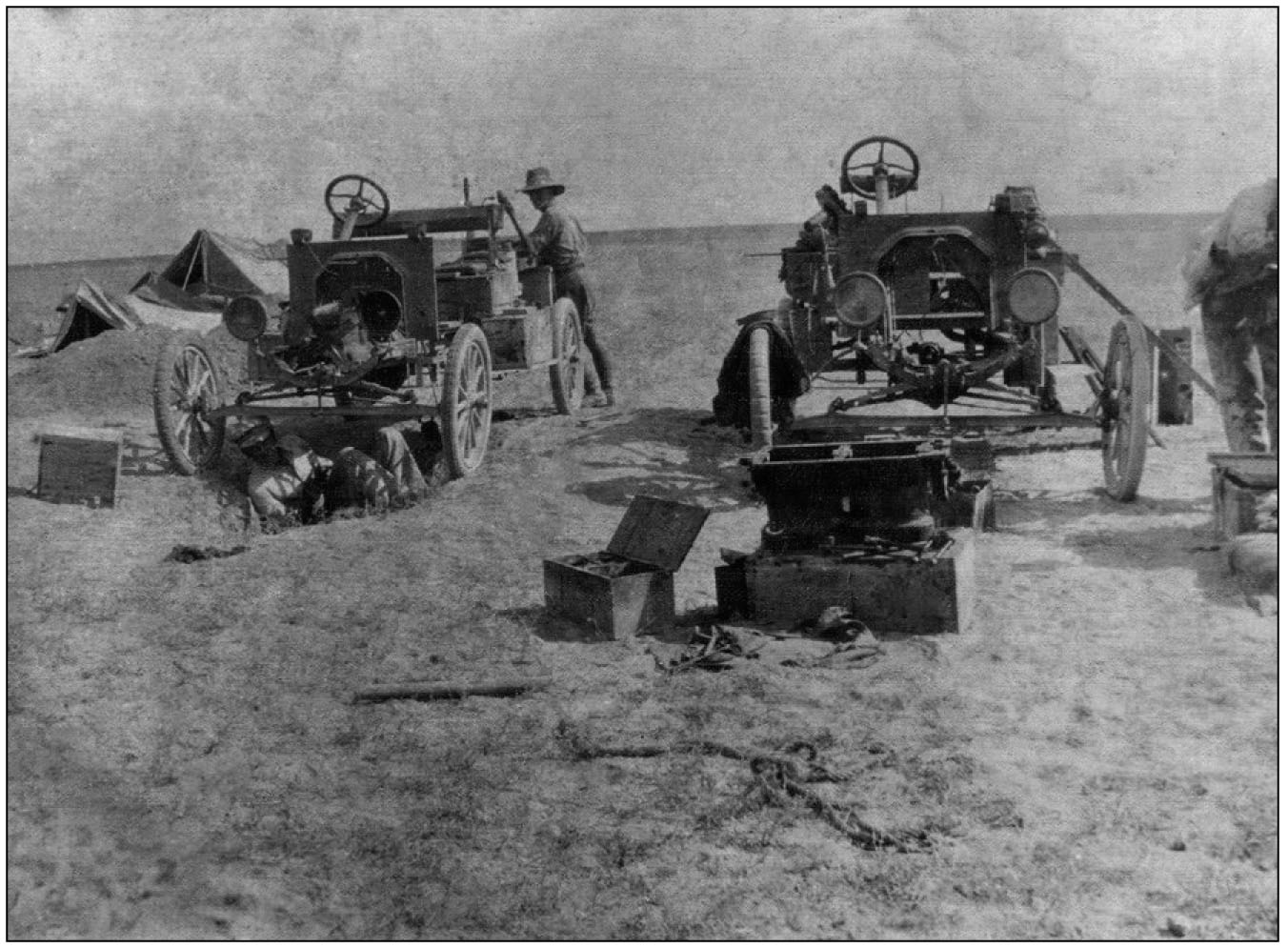
42. Light cars in various states of repair at a desert encampment in Palestine with three drivers working on mechanical problems (ATM. LCP. 001).
On Tuesday 30th April and Wednesday 1st May, another big attack was made on Shunet Nimrin by the infantry and further north by the Light Horse Regiments. This attack was not altogether a success from all points of view and at times things were very mixed. We were ordered to stand by with cars ready for a dash at any moment to places that might need assistance. About noon on the Wednesday, word was received that the 4th Light Horse Regiment had been cut off by the enemy, and that General Chaytor the Divisional Commander was motoring with his escort directly into the enemy’s lines. One of our cars was sent off to chase him at full speed and warn the party of its danger but fortunately we discovered that they had already been warned of the enemy’s new position. Our base of operations for this two days’ fighting was a place known as Um-esh-skirt and we slept in the scrub for the night. Next morning an enemy bombing squadron dropped a large number of bombs amongst our forces but did very little damage considering the large numbers of troops moving about.
We had a little more machine-gun practise at the aeroplane but with no apparent result. At 6 o’clock that evening we were all back again at Jericho as the attack was over and everything was quiet once more except for occasional shots from outposts.
Throughout the month of May the Patrol was stationed alternately around Jericho and at different points along the river front. The heat by day was very severe and almost unbearable and the dust was choking. The flies were a black mass over everything and at night the sand flies and mosquitoes took over their duties to make our lives as miserable as possible. The flies were so thick that it was absolutely impossible to get food to one’s mouth without some flies going with it. In fact, many of us cut our meals down to two a day (one in the early morning before the flies were up and the other in the evening after they went to bed). One genius discovered a method of beating the flies for the midday meal. He built a small frame with sticks large enough to sit in. This he surrounded it with a mosquito net into which he took his tin of jam, biscuits and mug of tea. He then proceeded to kill off the flies inside the curtain and then calmly ate his meal to the maddened buzz of the insects outside the curtain who could not reach him. After he had finished his meal others would take their turn. The men on outpost work near the river at night time had a miserable time as the swarms of sand flies and mosquitoes would leave their faces and hands like raw beef. After three months of this misery in the Jordan Valley we were given a fortnight’s leave to overhaul our cars and recuperate up in the hills at Bethlehem. The cooler climate was a great relief after the uncomfortable valley but we were all very sorry when the two weeks was up and we had to return to the heat, filth and flies again.
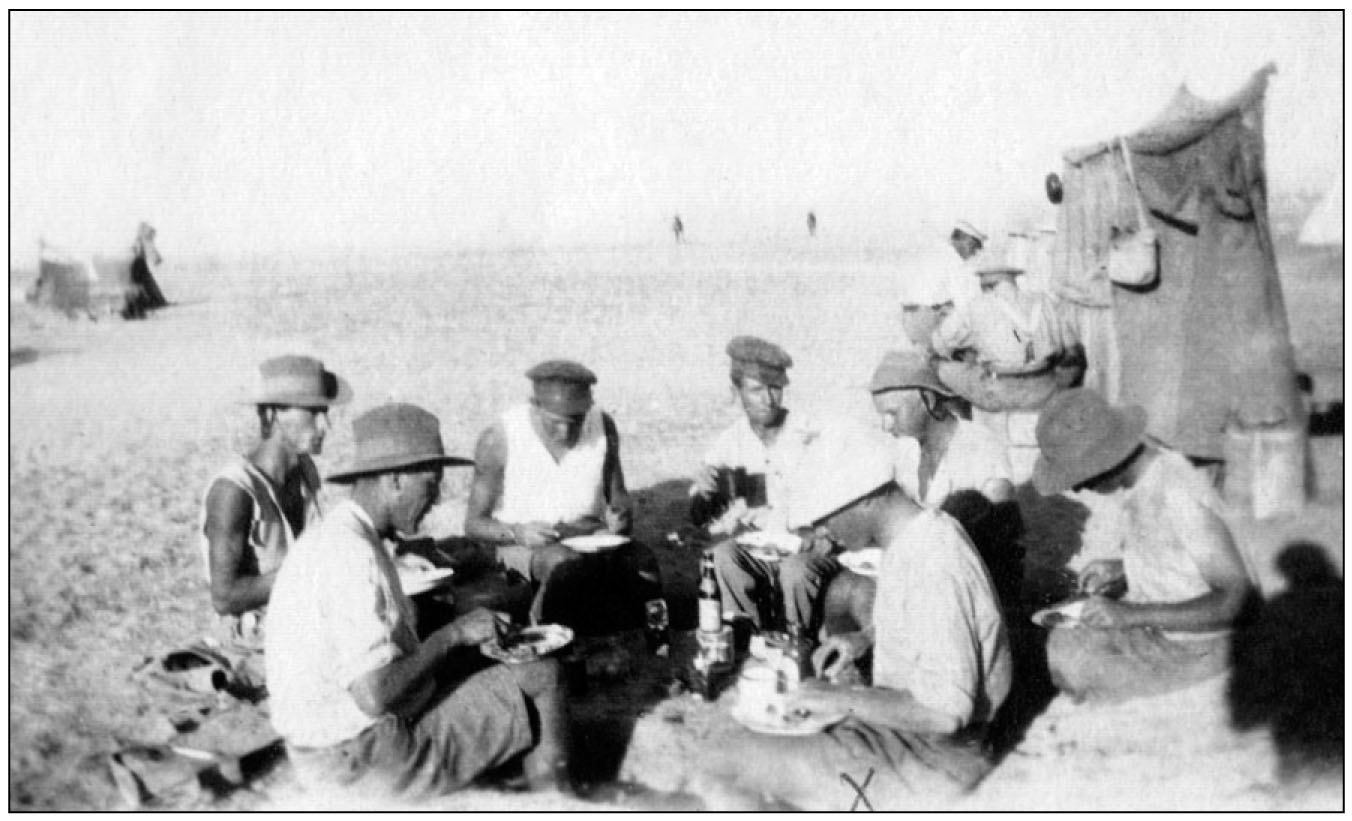
43. Brew up: crews enjoy a meal somewhere in Palestine in 1917 (Creek collection ATMLCP.HC.081).
This time our camp was made at the base of Mount Kurun-tel, which was nearly ten miles from the enemy’s front line. A few days afterwards we were very surprised to find high velocity shells exploding around us, as under ordinary circumstances this would have been out of range. We heard afterwards that the Turks had taken some of the long range naval guns from the old “Goebern” and had manoeuvred them overland to the hills opposite where they were enjoying themselves at our expense. However, the range was too long for them to see what they were doing and most of their shooting was harmless.